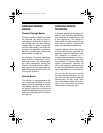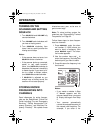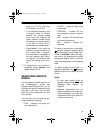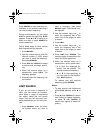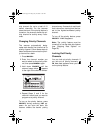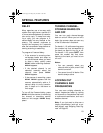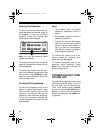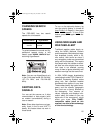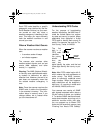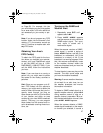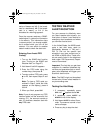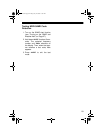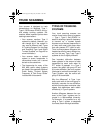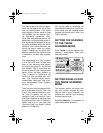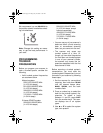
25
CHANGING SEARCH
SPEEDS
The PRO-2052 has two search
speeds for a limit search.
To switch between the normal and Hy-
perSearch speeds during a limit
search, press
SPEED
.
SEARCH
flash-
es during HyperSearch.
Note:
You can use HyperSearch only
in the 5 kHz step bands (29–54 MHz,
137–174 MHz, and 216–224.995
MHz).
SKIPPING DATA
SIGNALS
You can set the scanner so it skips
nonmodulated or data signals (such
as modem transmissions) during a
scan or search.
Note:
Since data signals are not gen-
erally found in the air and VHF TV
bands, this feature does not work in
those bands.
To turn on the data skip feature, be
sure the priority feature is turned off
(see “Priority” on Page 21), then press
DATA
.
DATA
appears. To turn off the
feature, press
DATA
again.
DATA
dis-
appears.
USING NWR-SAME AND
WEATHER ALERT
Traditional weather radios simply re-
ceive the NOAA (National Oceanic
and Atmospheric Administration) wea-
ther broadcast (usually within a 50-
mile radius), then sound an alarm if
any emergency code was transmitted
along with the broadcast. This means
that people who live outside an affect-
ed area are often alerted even when
their area is not affected, causing
many of them to ignore potentially real
weather warnings that can save lives.
In 1994, NOAA began broadcasting
coded signals called FIPS (Federal In-
formation Processing System) codes
along with their standard weather
broadcasts from stations in your area.
These codes identify the type of emer-
gency and the specific geographic
area (such as a county) affected by
the emergency. Your scanner re-
ceives, interprets, and displays infor-
mation about the codes so you can
determine if the emergency might
affect your area.
Only SAME-
compatible radios (such as this
scanner) are able to take advantage
of this new technology.
Normal Search HyperSearch
100 steps/
second
300 steps/
second
20-432.fm Page 25 Friday, July 14, 2000 11:30 AM



